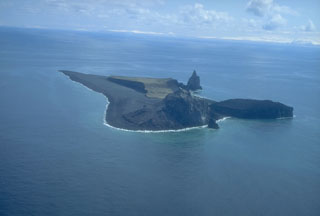Report on Bogoslof (United States) — 11 January-17 January 2017
Smithsonian Institution / US Geological Survey
Weekly Volcanic Activity Report, 11 January-17 January 2017
Managing Editor: Sally Sennert.
Please cite this report as:
Global Volcanism Program, 2017. Report on Bogoslof (United States) (Sennert, S, ed.). Weekly Volcanic Activity Report, 11 January-17 January 2017. Smithsonian Institution and US Geological Survey.
Bogoslof
United States
53.93°N, 168.03°W; summit elev. 150 m
All times are local (unless otherwise noted)
AVO reported that photos taken by a pilot on 10 January showed Bogoslof covered with dark gray ash, and a roughly 300-m-diameter submarine explosion crater on the E side of the island. Unrest continued during 11-17 January. Two short-lived explosions (five to six minutes long) were seismically detected at 1123 and 1230 on 12 January and observed by pilots. The estimated altitudes of the first and second plumes were 5.5 and 4.4 km (18,000 and 14,500 ft) a.s.l., respectively. Seismicity again increased at 2126 on 14 January and remained elevated. Six explosive events were detected between 2216 on 14 January and 0350 on 15 January. No volcanic clouds were identified in satellite data, although one lightning strike was recorded at 2232 on 14 January. Increased seismicity on 17 January indicated minor explosive activity; steam plumes with minor amounts of ash rose no higher than 4.6 km (15,000 ft) a.s.l. The Aviation Color Code remained at Orange and the Volcano Alert Level remained at Watch.
Geological Summary. Bogoslof is the emergent summit of a submarine volcano that lies 40 km N of the main Aleutian arc. It rises 1,500 m above the Bering Sea floor. Repeated construction and destruction of lava domes at different locations during historical time has greatly modified the appearance of this "Jack-in-the-Box" volcano and has introduced a confusing nomenclature applied during frequent visits by exploring expeditions. The present triangular-shaped, 0.75 x 2 km island consists of remnants of lava domes emplaced from 1796 to 1992. Castle Rock (Old Bogoslof) is a steep-sided pinnacle that is a remnant of a spine from the 1796 eruption. The small Fire Island (New Bogoslof), about 600 m NW of Bogoslof Island, is a remnant of a lava dome formed in 1883.
Source: US Geological Survey Alaska Volcano Observatory (AVO)

